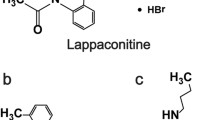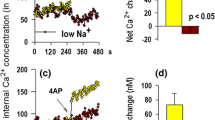Summary
The influence of local and general anaesthetics on cation influx through the fast, voltage-dependent sodium channel and the 5-HT3 receptor cation channel was studied in N1E-115 mouse neuroblastoma cells by measuring 2-min influx of the organic cation 14C-guanidinium induced by either veratridine (1 mmol/l) or 5-HT (100 μmol/l).
The veratridine-induced influx of 14C-guanidinium was potentiated by scorpion toxin and inhibited by tetrodotoxin. The 5-HT-induced 14C-guanidinium influx was not affected by tetrodotoxin but it was inhibited by nanomolar concentrations of the selective 5-HT3 receptor antagonists ondansetron and ICS 205–930; at high micromolar concentrations these compounds also inhibited the veratridine-induced influx of 14C-guanidinium. The 14C-guanidinium influx through both channels was inhibited by local and general anaesthetics. The rank order of potency for inhibition of veratridine-induced influx by local anaesthetics was tetracaine > bupivacaine > cocaine > lidocaine > procaine and that for inhibition of the 5-HT3 receptor channel was tetracaine > bupivacaine > cocaine > procaine > lidocaine. With the exception of procaine and cocaine, which were equipotent at both channels, the local anaesthetics were 4.4-fold (lidocaine) to 25-fold (tetracaine) more potent at the fast sodium channel than at the 5-HT3 receptor channel. The rank order of potency for general anaesthetics was propofol > etomidate = alfaxalone = ketamine > thiopental = methohexital at the fast sodium channel, and propofol ≥ etomidate > alfaxalone = methohexital > thiopental > ketamine at the 5-HT3 receptor channel. With the exception of ketamine, which was about equipotent at both channels, the general anaesthetics were between 2.2 to 8.1-fold more potent at the 5-HT3 receptor channel than at the fast sodium channel. Propofol and alfaxalone non-competitively inhibited the 5-HT-induced influx of 14C-guanidinium. The pIC50 values of local and general anaesthetics for inhibition of veratridine-induced 14C-guanidinium influx were correlated with the lipophilicity (log P values) of these compounds, whereas no correlation was found between the corresponding paramaters for the 5-HT-induced influx.
In conclusion, the results indicate that not only the fast Na+ channel but also the 5-HT3 receptor channel is a target for local and general anaesthetics. The relative high inhibitory potencies of the general anaesthetics which were not correlated with log P values argue in favour of a specific interaction of these agents with the 5-HT3 receptor channel.
Similar content being viewed by others
References
Amano T, Richelson E, Nirenberg PG (1972) Neurotransmitter synthesis by neuroblastoma clones. Proc Natl Acad Sci USA 69:258–263
Barann M, Bönisch H (1992) Inhibition by anaesthetics and steroids of 5-HT3 receptor-mediated influx of 14C-guanidinium ions in neuroblastoma cells. Naunyn-Schmiedeberg's Arch Pharmacol 345 [Suppl]:R112
Barann M, Graupner J, Göthert M, Bönisch H (1991) Properties of the 5-HT3-receptor on N1E-115 neuroblastoma cells studied by guanidinium ion influx. Naunyn-Schmiedeberg's Arch Pharmacol 344 [Suppl]:R36
Benoit E, Carratu MR, Dubois JM, Mitolo-Chieppa D, Preziosi P (1987) Electrophysiological studies of the effects of the general anaesthetic etomidate on frog myelinated nerve fibre. Br J Pharmacol 90:7–14
Benoit E, Carratu MR, Mitolo-Chieppa D (1988) Interactions between molecules of a steroid anaesthetic (alphaxalone) and ionic channels of nodal membrane in voltage-clamped myelinated nerve fibre. Br J Pharmacol 94:635–646
Blaustein MP (1968) Barbiturates block sodium and potassium conductance increase in voltage-clamped lobster axons. J Gen Physiol 51:293–307
Bönisch H, Barann M, Graupner J, Göthert M (1993) Characterization of 5-HT3 receptors of N1E-115 neuroblastoma cells by use of the influx of the organic cation [14C]-guanidinium. Br J Pharmacol (in press)
Burch PG, Stansky DR (1983) The role of metabolism and protein binding in thiopental anesthesia. Anesthesiology 58:146–152
Carlon GC, Khan RC, Goldener PL, Howlands WS, Turnbull A (1978) Long-term infusion of sodium-thiopental. Crit Care Med 6:311–316
Catterall WA (1980) Neurotoxins that act on voltage-sensitive sodium channels in excitable membranes. Ann Rev Pharmacol Toxicol 20:15–43
Concas A, Santoro G, Mascia MP, Serra M, Sanna E, Biggio G (1990) The general anesthetics propofol enhances the function of γ-aminobutyric acid-coupled chloride channel in the rat cerebral cortex. J Neurochem 55:2135–2138
Cottrell GA, Lambert JJ, Peters JA (1987) Modulation of GABAA receptor activity by alphaxalone. Br J Pharmacol 90:491–500
Derkach V, Surprenant A, North RA (1989) 5-HT3 receptors are membrane ion channels. Nature 339:706–709
De Ruiter G, Popescu DT, De Boer AG, Smeekens JB, Breimer DD (1981) Pharmacokinetics of etomidate in surgical patients. Arch Int Pharmacodyn 249:180–188
Dilger JP, Firestone LL (1990) More models described for molecular “target” of anaesthetics and alcohols. Trends Pharmacol Sci 11:431–432
Dluzewski AR, Halsey MJ, Simmonds AC (1983) Membrane interactions with general and local anaesthetics: a review of molecular hypotheses of anaesthesia. Mol Aspects Med 6:459–573
El-Maghrabi EA, Eckenhoff RG, Shuman H (1992) Saturable binding of halothane to rat brain synaptosomes. Proc Natl Acad Sci USA 89:4329–4332
Forman SA, Miller KW (1989) Molecular sites of anesthetic action in postsynaptic nicotinic membranes. Trends Pharmacol Sci 10:447–452
Fozard JR (1990) Agonists and antagonists of 5-HT3 receptors. In: Saxena PR, Wallis DI, Wouters W, Bevan P (eds) Cardiovascular pharmacology of 5-hydroxytryptamine; Kluwer Academic Publishers, Dordrecht, Boston, London pp 101–115
Franks NP, Lieb WR (1984) Do general anaesthetics act by competitive binding to specific receptors. Nature 310:599–601
Frenkel C, Urban BW (1991) Human brain sodium channels as one of the molecular target sites for the new intravenous anaesthetic propofol (2,6-diisopropyl-phenol). Eur J Pharmacol — Mol Pharmacol Sect 208:75–79
Gepts E, Camu F, Cockshott ID, Douglas EJ (1985) Disposition of propofol administered as zero-order intravenous infusions in humans. Anesth Analg 64:1256–1263
Glanville TN, Spence MW, Cook HW, Palmer FBStC (1988) Sodium channel activation does not alter lipid metabolism in cultured neuroblastoma cells. Neurochem Res 13:1015–1021
Göthert M (1978) Modification of catecholamine release by anaesthetics and alcohols. In: Paton DM (ed) The release of catecholamines from adrenergic neurons. Pergamon Press, Oxford, New York, pp 241–261
Göthert M, Dorn W, Loewenstein I (1976 a) Inhibition of catecholamine release from the adrenal medulla by halothane. Naunyn-Schmiedeberg's Arch Pharmacol 294:239–249
Göthert M, Kennerknecht E, Thielecke G (1976 b) Inhibition of receptor-mediated noradrenaline release from the sympathetic nerves of the isolated rabbit heart by anaesthetics and alcohols on proportion to their hydrophobic property. Naunyn-Schmiedeberg's Arch Pharmacol 292:145–152
Göthert M, Dührsen U, Rieckesmann JM (1979) Ethanol, anaesthetics and other lipophilic drugs preferentially inhibit 5-hydroxytryptamine and acetylcholine-induced noradrenaline release from sympathetic nerves. Arch Int Pharmacodyn Ther 242:196–209
Haky JE, Young AM (1984) Evaluation of a simple HPLC correlation method for the estimation of the octanol-water partition coefficient of organic compounds. J Liq Chromatogr 7:675–689
Hales TG, Lambert JJ (1991) The actions of propofol on inhibitory amino acid receptors of bovine adrenomedullary chromaffin cells and rodent central neurones. Br J Pharmacol 104:619–628
Honerjäger P, Frelin C, Lazdunski M (1982) Actions, interactions and apparent affinities of various ceveratrum alkaloids at sodium channels of cultured neuroblastoma and cardiac cells. Naunyn-Schmiedeberg's Arch Pharmacol 321:123–129
Hoyer D, Neijt HC (1988) Identification of serotonin 5-HT3 recognition sites in membranes of N1E-115 neuroblastoma cells by radioligand binding. Mol Pharmacol 33:303–309
Jacques Y, Fosset M, Lazdunski M (1978) Molecular properties of the action potential Na+ ionophore in neuroblastoma cells. Interactions with neurotoxins. J Biol Chem 253:7383–7392
Johnston RR, Miller RD, Way WL (1974) The interaction of ketamine with d-tubocurarine, pancuronium, and succinylcholine in man. Anesth Analg 53:496–501
Kilpatrick GJ, Bunce KT, Tyers MB (1990) 5-HT3 receptors. Medic Res Rev 10:441–475
Kojda G, Klaus W, Werner G, Fricke U (1991) The influence of 3-ester side chain variation on the cardiovascular profile of nitrendipine in porcine isolated trabeculae and coronary arteries. Naunyn-Schmiedeberg's Arch Pharmacol 344:488–494
Lowry OH, Rosebrough NJ, Farr AL, Randall RJ (1951) Protein measurement with the Folin phenol reagent. J Biol Chem 193:265–275
Maricq AV, Peterson AS, Brake AJ, Myers RM, Julius D (1991) Primary structure and functional expression of the 5-HT3 receptor, a serotonin-gated ion channel. Science 254:432–437
McNeal ET, Lewandowski GA, Daly JW, Creveling CR (1985) [3H]Batrachotoxinin 20 -benzoate binding to voltage-sensitive sodium channels: A rapid and quantitive assay for local anaesthetic activity in a variety of drugs. J Med Chem 28:381–388
Meyer H (1899) Zur Theorie der Alkoholnarkose. Erste Mittheilung. Welche Eigenschaft der Anästhetica bedingt ihre narkotische Wirkung? Arch Exp Pathol Pharmakol 42:109–118
Miller KW, Braswell LM, Firestone LL, Dodson BA, Forman SA (1986) General anaesthetics act both specifically and nonspecifically on acetylcholine receptors. In: Roth SH, Miller KW (eds) Molecular and cellular mechanisms of anaesthetics. Plenum, New York, pp 125–137
Neijt HC, TeDuits IJ, Vijverberg HPM (1988) Pharmacological characterization of serotonin 5-HT3 receptor-mediated electrical response in cultured mouse neuroblastoma cells. Neuropharmacology 27:301–307
Neijt HC, Plomp JJ, Vijverberg HPM (1989) Kinetics of the membrane current mediated by serotonin 5-HT3 receptors in cultured mouse neuroblastoma cells. J Physiol (Lond) 411:257–269
Olsen RW (1982) Drug interactions at the GABA receptor-ionophore complex. Ann Rev Pharmacol Toxicol 122:245–277
Overton E (1901) Studien über die Narkose zugleich ein Beitrag zur allgemeinen Pharmakologie. G. Fischer, Jena
Peters JA, Usherwood PNR (1983) 5-Hydroxytryptamine responses of murine neuroblastoma cells. Ions and putative antagonists. Br J Pharmacol 180: 523P
Proctor WR, Mynlieff M, Dunwiddie TV (1986) Facilitatory action of etomidate and pentobarbital on recurrent inhibition in rat hippocampal pyramidal neurons. J Neurosci 6:3161–3168
Reiser G, Günther A, Hamprecht B (1983) Blockade by neurotransmitter antagonists of veratridine-activated ion channels in neuronal cell lines. J Neurochem 40:493–502
Reith MEA (1990) 14C-guanidinium ion influx into Na+-channel preparations from mouse cerebral cortex. Eur J Pharmacol 188:33–41
Richards CD (1983) Actions of general anaesthetics on synaptic transmission in the CNS. Br J Anaesth 55:201–207
Scholtysik G, Imoto Y, Yatani A, Brown AM (1988) 5-Hydroxytryptamine antagonist ICS 205–930 blocks cardiac potassium, sodium and calcium currents. J Pharmacol Exp Ther 245:773–778
Schüttler J, Stoeckel H, Schwilden H (1985) Pharmacokinetic and pharmacodynamic modelling of propofol (“Diprivan”) in voltunteers and surgical patients. Postgrad Med J 61:53–54
Sear JW, Prys-Roberts C (1979) Plasma concentrations of alphaxalone during continuous infusion with Althesin. Br J Anaesth 51:861–865
Shafer A, Doze VA, Shafer SL, White PF (1988) Pharmacokinetics and pharmacodynamics of propofol infusions during general anaesthesia. Anesthesiology 69:348–353
Takara H, Wada A, Arita A, Sumikawa K, Izumi F (1986) Ketamine inhibits 45Ca influx and catecholamine secretion by inhibiting 22Na influx in cultured bovine adrenal medullary cells. Eur J Pharmacol 125:217–224
Tas PWL, Kress HG, Koschel K (1987) General anaesthetics can competitively interfere with sensitive membrane proteins. Proc Natl Acad Sci USA 84:5972–5975
Todd MM, Brummond JC, Hoi Sang U (1984) The chemodynamic consequences of high-dose methohexital anesthesia in humans. Anesthesiology 61:495–501
Ueda I, Kamaya H (1973) Kinetic and thermodynamic aspects of the mechanism of general anaesthetics in a model system of firefly luminescence in vitro. Anesthesiology 38:425–436
Van Hamme MJ, Ghoneim MM, Ambre JJ (1978) Pharmacokinetics of etomidate, a new intravenous anesthetic. Anesthesiology 49:274–277
Wachtel RE, Wegrzynowicz ES (1992) Kinetics of nicotinic acetylcholine ion channels in the presence of intravenous anaesthetics and induction agents. Br J Pharmacol 106:623–627
White PF, Way WL, Trevor AJ (1982) Ketamine: Its pharmacology and therapeutic uses. Anesthesiology 56:119–136
Wieber J, Gugler R, Hengstmann JH, Dengler HJ (1975) Pharmacokinetics of ketamine in man. Anaesthesist 24:260–263
Yamamura T, Harada K, Okamura A, Kemmotsu O (1990) Is the site of action of ketamine anesthesia the N-methyl-D-aspartate receptor? Anesthesiology 72:704–710
Author information
Authors and Affiliations
Additional information
Correspondence to: H. Bonisch at the above address
Rights and permissions
About this article
Cite this article
Barann, M., Göthert, M., Fink, K. et al. Inhibition by anaesthetics of 14C-guanidinium flux through the voltage-gated sodium channel and the cation channel of the 5-HT3 receptor of N1E-115 neuroblastoma cells. Naunyn-Schmiedeberg's Arch Pharmacol 347, 125–132 (1993). https://doi.org/10.1007/BF00169256
Received:
Accepted:
Issue Date:
DOI: https://doi.org/10.1007/BF00169256




